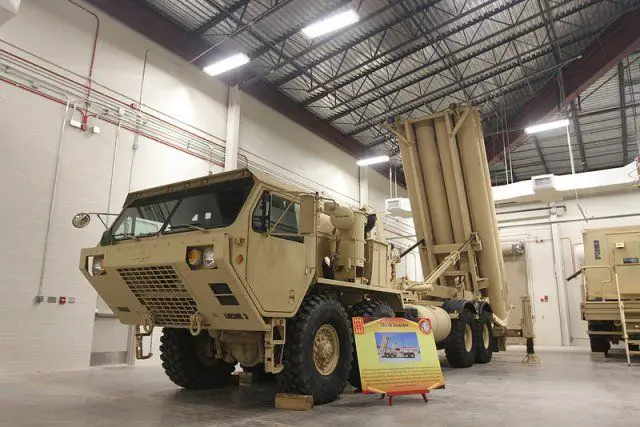US Army opens first Terminal High Altitude Area Defense Instructional Facility at Fort Sill
|
|
|||
|
US Army THAAD new training center |
|||
|
a
|
|||
|
|
|||
| US Army opens first Terminal High Altitude Area Defense Instructional Facility at Fort Sill | |||
|
The US Army's soldiers destined to operate the Terminal High Altitude Area Defense system will now learn their trade from fellow Soldiers. The Terminal High Altitude Area Defense Instructional Facility, or THAAD, opened at Fort Sill, Oklahoma. Already, four classes are underway at the schoolhouse, announced the US Army on January 23.
|
|||
|
|
|||
 A Terminal High Altitude Area Defense, or THAAD, missile launcher sits in the new THAAD Instruction Facility at Fort Sill, Oklahoma A Terminal High Altitude Area Defense, or THAAD, missile launcher sits in the new THAAD Instruction Facility at Fort Sill, Oklahoma (Credit: US Army) |
|||
|
|
|||
|
"This represents the culmination of a lot of activity to get the facility built, the instructors trained, and the training devices built and delivered," said Brig. Gen. Christopher Spillman, commandant of the Air Defense Artillery School, located at the Fires Center of Excellence. "All of that required a monumental amount of work and coordination from various stakeholders across the air defense artillery community."
In the past, Soldier training for THAAD was done by contractors. That is standard for new Army systems, Spillman said. But as those systems mature, and the cadre of Soldiers familiar with those systems grows, the Army can instead come to rely on its own non-commissioned officers to train newcomers. "Today marks the transition from the way we used to train Soldiers to now, having the Army train our Soldiers in the institutional training base," Spillman said. The THAAD system provides a globally transportable, rapidly deployable capability to intercept and destroy ballistic missiles inside or outside the atmosphere during their final, or terminal, phase of flight. A THAAD battery includes up to six truck-mounted launchers, each with the capability to store eight interceptor projectiles, a radar system, and a fire control system. Spillman said such a battery might have as many as 80 Soldiers on board. Soldiers who are bound for those units will first attend schooling at the new THAAD training facility at Fort Sill. Right now, Spillman said the schoolhouse teaches five courses of instruction, including one for new air defense artillery officers, a separate course for warrant officers, and courses to provide THAAD skill identifiers to each of three enlisted military occupational specialties. Today, the Army has fielded three THAAD batteries, with a fourth battery now stood up and going through new equipment training. In the coming years, Spillman said, the Army will stand up and equip another three batteries, with potential for an eighth battery. "The THAAD is an important system for national defense," Spillman said. "When you deploy a THAAD battery, or any air and missile defense capability for that matter, it sends a pretty powerful signal to adversaries in our various regions, that those areas are of important national interest to the United States." Most recently, Spillman said, the United States sent such a message to adversaries in Northeast Asia by locating a THAAD battery in Guam. "THAAD has been a major success story for the United States and for the Missile Defense Agency," Spillman said. |
|||
|
|


























